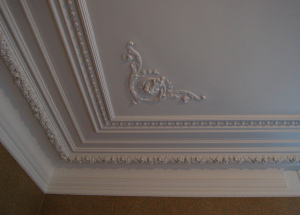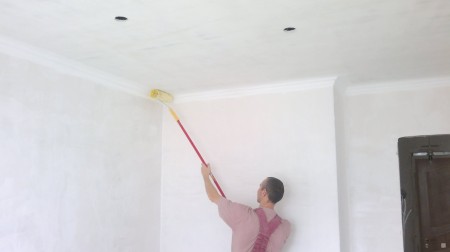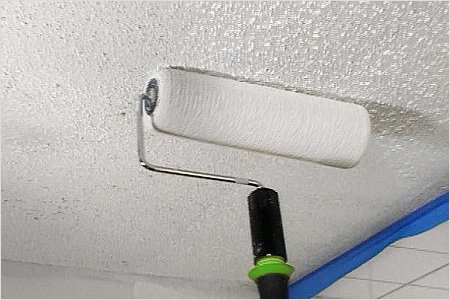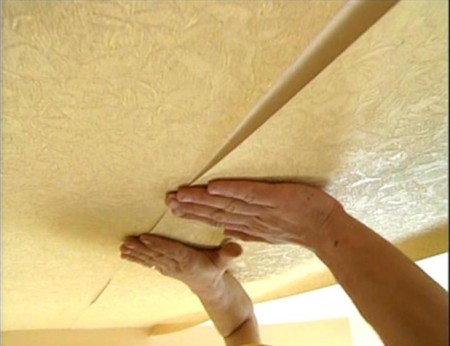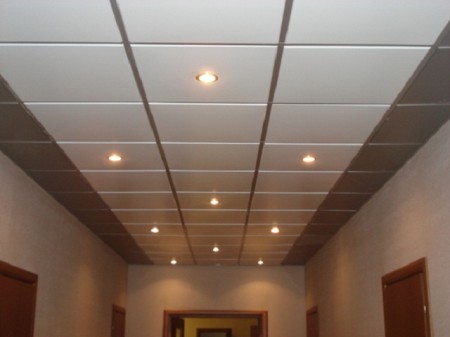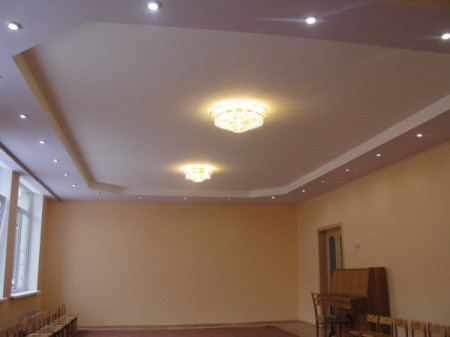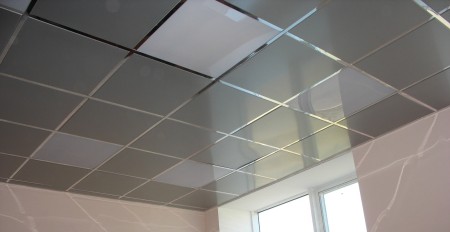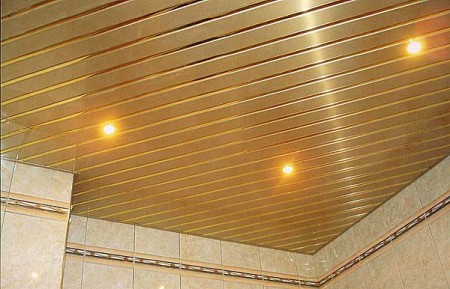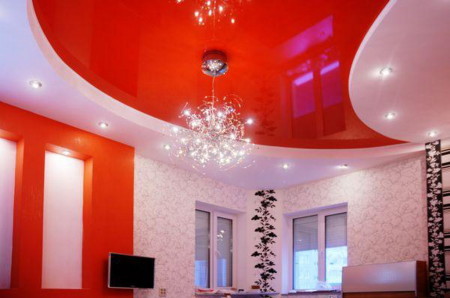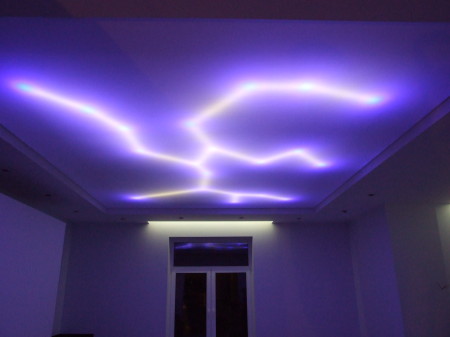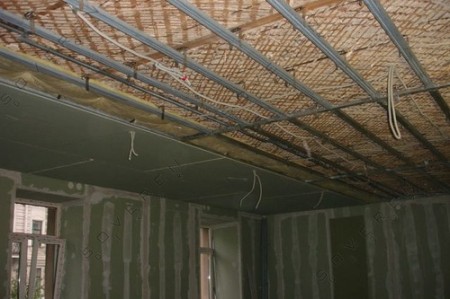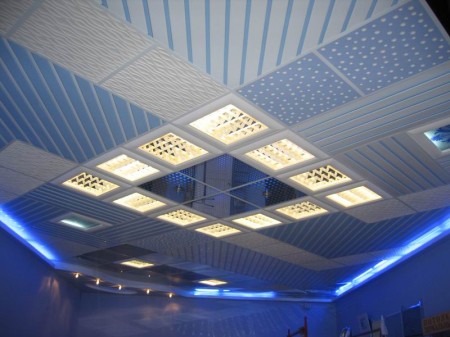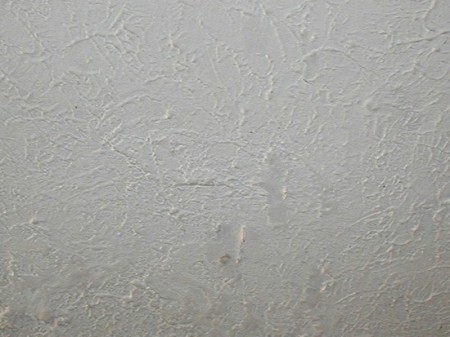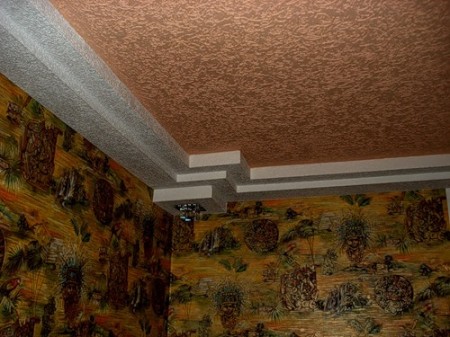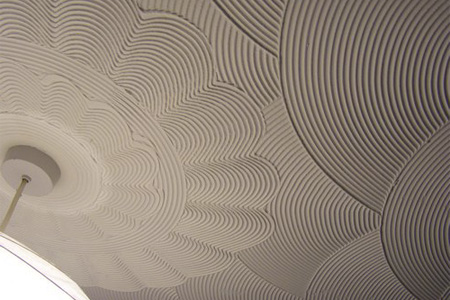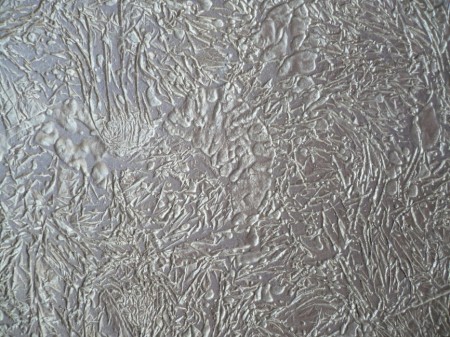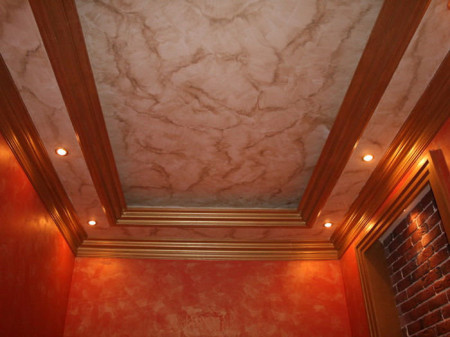Planning a renovation in an apartment or a private house, people ask themselves: how and how beautifully to trim the ceilings? But before you ask yourself how to make the ceiling beautiful, note to the height of the ceiling of your house. It's one thing if the ceiling is a standard height and a completely different question arises before you, if the ceiling is very high (up to 5 meters and above). At this ceiling height, it is necessary to use scaffolding or towers. And what option to finish the ceiling, you choose, after reading this article.
In this publication, we will look at the most popular ceiling finishes today.
Content
Whitewash
A traditional type of finishing the ceiling surface, gradually and irrevocably leaving in the past. A whitewash is a covering of a surface of a ceiling by a solution of lime or a chalk. Whitewashing gives the ceiling a snow-white tint, which blends well with almost any interior.
This type of ceiling finishing requires preparation works, which sometimes are quite laborious: surface cleaning, leveling, puttying and plastering. The main advantage of whitewashing is the ridiculously low cost of the material and the ease in coating.
But this type of ceiling finish has a number of drawbacks:
- Great complexity of preparatory work.
- The fragility of whitewash. The coating retains a saturated white color for no more than two years, after which it begins to darken and crumble.
- Whitewashing is extremely unstable to moisture, moreover, whitewashed surface is very easy to soil, and it is impossible to wash it off - you have to whitewash again.
Painting the ceiling
Covering the ceiling with a layer of paint is a rather popular and effective way of finishing the ceiling space. Among the many advantages of this method of finishing the main place is occupied by an extremely wide color range. For the ceiling, you can choose a color for any interior and for every taste. The cost of painting the ceiling is slightly higher than whitewashing. This is a practical and simple way to decorate the ceiling in your home.
As for the shortcomings, they are almost the same as whitewash: labor-intensive preparatory work, fragility (no more than 2-3 years). Over time, the painted ceiling inevitably appears cracks.
However, the longevity of such coverage depends to a large extent on the quality of the preparatory work and the skill of the finisher.
Pasting the ceiling with wallpaper
A modern, beautiful and practical way of finishing the ceiling. For the ceiling surfaces special thick wallpaper is sold. Most often for gluing ceilings are used non-woven wallpaper light light tones.
But, despite the fact that the wallpaper is relatively inexpensive, and the wallpapered wallpaper looks very attractive, this method of decoration is also not devoid of shortcomings.
The work is quite labor-intensive, and it is by no means possible for every designer to paste the wallpaper on the ceiling himself. Wallpapers from the ceiling are very often peeled off, for example, from drafts, and, in general, such coverage does not last long - the wallpaper eventually fades, frowns and loses its original appearance.
Adhesive ceilings
This decorative finish of ceilings is widespread. It consists in the fact that on the surface of the ceiling are glued square (or other forms) tiles. The main advantage of glued ceilings is the ability to glue the material on almost any surface.
Tiles are very small in weight, made of expanded polystyrene. The front side of the material is decorated with a variety of graphic inclusions and a relief pattern.
Of the advantages of this method of finishing the ceiling, first of all, it is necessary to note the simplicity of work and good maintainability of the material - any tile can be easily removed and replaced. The glued ceiling hides the cracks and small flaws of the ceiling surface well.
Of the disadvantages can be noted heterogeneity of finishing - pasted tiles are not perceived as a single picture. All the seams and unevenness of the ceiling under such a coating will be clearly seen, besides, in case of direct sunlight, the polystyrene becomes dull and starts to burn out. It is not recommended to trim the ceiling with tiles until all the necessary communications have been laid, as this can cause difficulty with their installation.
Dropped ceilings
Also very common way of finishing the ceilings. Suspended ceilings are multifunctional designs, and this is the main reason for their popularity. Suspended ceiling can hide any flaws in the ceiling surface, and disguise communications - wiring, ventilation, pipes, etc.
In the modern market there are many varieties of suspended ceilings, the most popular of them are:
ceiling of plasterboard
It is a design from metal guides and installed in them plasterboard boards. The finishing of the gypsum cardboard ceiling opens wide opportunities for creating various ceiling compositions and images, with the help of this material you can realize the most daring solutions.
Advantages of such a ceiling - a relatively small cost, ease of installation, the ability to create multi-level designs independently, without resorting to the services of professionals.
Ceilings from gypsum cardboard do not have any significant drawbacks, you just need to avoid getting moisture on gypsum.
cassette suspended ceiling
This type of ceiling is a design of thin metal plates - cassettes. The front side of the finishing material is characterized by a wide variety of coatings: it can be any color, or a corrugated pattern that can be selected to suit your taste or the interior of the room.
Cassette ceilings are very convenient to maintain, cassettes are easily removed and washed, if necessary, they are very easy to replace.
The whole design weighs very little, because when it is manufactured, light metals and alloys are used. The cassette ceiling well resists temperature changes and is impervious to moisture.
But for all these advantages, the owners will have to pay a tidy sum. To the disadvantages of such a ceiling can also be attributed to poor sound insulation of the cassette cover.
rack suspended ceiling
It is a coating collected from metal plates (aluminum, steel, etc.). Roof ceilings are mounted, mainly in small rooms.
Like the cassette, the rack ceiling has a fairly large color range, up to a mirror or gold coating. On sale there are designs with a wide variety of relief patterns and patterns that can be selected for any interior.
Of the merits of this type of decoration we note: a small weight of the structure, a large selection of colors, shades and patterns, the possibility of creating multi-level structures, decoration of arches, ease of installation, durability and high resistance to moisture and temperature changes.
Stretch ceiling
This type of decoration of ceilings has long been appreciated by the consumer as worthy as practical, beautiful and affordable. Cloth stretch ceilings are made of polymer materials, characterized by high strength and durability.
With the help of tensioning fabrics it is possible to create very reliable and beautiful coatings for the ceiling surface. Stretch ceilings have the richest range of colors, patterns and patterns that will give the room comfort and comfort. Despite the fact that the stretch ceiling will cost you more than wallpapering or painting, it costs its money, as it serves for decades, almost without losing its original appearance.
Stretch ceilings are completely waterproof, they do not burn, are highly durable, they can be installed in kitchens and bathrooms.
A greater effect can be achieved by installing a "right" illumination on the stretch ceiling, the benefit of a translucent structure of the vinyl sheet substantially increases the possibilities of lighting devices. Recently, the LED strip, which is a current-conducting bus with LEDs on it, is gaining in popularity.
The disadvantages include the difficulty in installation, the high price of high-quality linens, the response to high temperature extremes - if the canvas is too high, it slackens, with a negative becomes rigid, loses its elasticity.
Choosing a way to finish the ceiling, remember that the tension and suspended ceilings "steal" about 20 cm of space in height.
Ceiling ceiling
The main difference between false ceilings is that they are mounted directly on profiles, which, in turn, are mounted directly on the ceiling. What is the advantage of this? The thing is that this kind of decoration practically does not conceal space, and therefore it is perfect for placing ms with low ceiling.
But, despite this, using a false ceiling can hide moderate irregularities on the ceiling surface. Modules of false ceiling are made of plastic, MDF, metal, chipboard and gypsum board.
As for the drawbacks of the false ceilings, here we refer the heavy weight of the structure, the inability to install lamps and other communications, as well as a modest set of colors and patterns.
Decorative plaster
Mixtures for decorative plasters are divided into several groups:
- For internal works.
- For outdoor works.
- Universal mixtures.
To finish the ceiling, the outdoor mixture does not fit perfectly, because it has slightly different properties. Therefore, for the application to the ceiling, you need to buy a mixture for interior decoration or universal. Also you need to decide on the composition of the mixture that will suit you for quality and price.
The most popular mixtures today are:
- Polymer - in its composition, as it is clear from the name, includes several types of polymers.
- Silicate - is a liquid potassium glass.
- Mineral - a mixture of lime and cement.
The appearance of the finished coating depends on the granules and the shape of the grains in the mixture, as well as on the tools used and the plastering technique.
If you decide to pick up a construction tool and work with the plaster mixture, you need to warn that the finishing works, although not the most difficult, but the most responsible, as the quality of their performance depends on the type of room.
Below we give some recommendations for working with decorative stucco mixes.
- Plaster is applied only on a dry and clean surface. It is not necessary at drawing of a mix strongly to try to repair all irregularities - decorative plaster will hide the most part of flaws.
- The mixture is thoroughly mixed with a drill bit. Stir at low speed so as not to damage the granules.
- The very process of applying the plaster is very similar to shpatlevanie: the mixture is applied smoothly and accurately leveled.
- To make the surface of the desired structure use plastic trowels, rollers and spatulas.
Decorating with decorative plaster can give a different effect. For example, applying a mixture in a circular motion, you can make a "shell".
Using a plastic float, you can apply circular or straight grooves to the surface, and by working with a spatula you will get a smooth smooth surface.
Using decorative mixtures on the ceiling, you can create an imitation of marble, mother of pearl or granite. True, applying such a plaster requires rather serious professional skills, so if you do not want to do everything, we advise you to hire specialists right away.
After the material dries, the surface can be covered with a layer of wax, this will help to give the surface a glossy sheen. Such a coating will serve as additional protection, and care for the surface will be much simpler.


